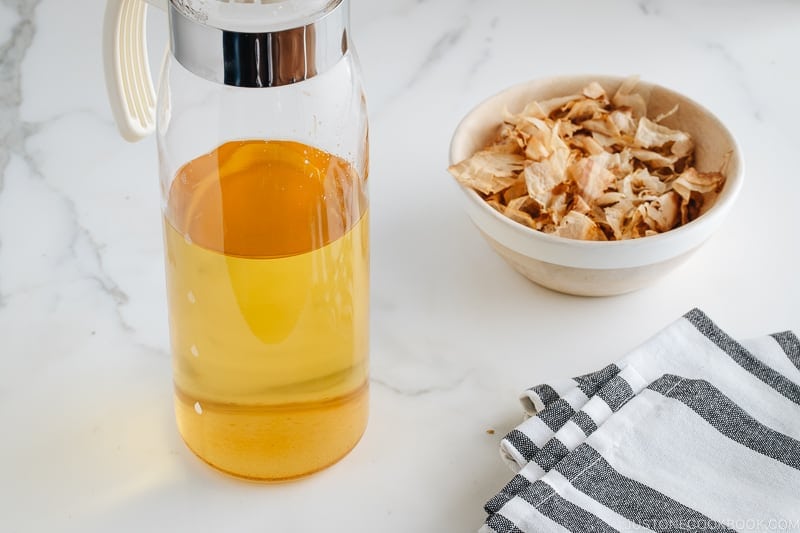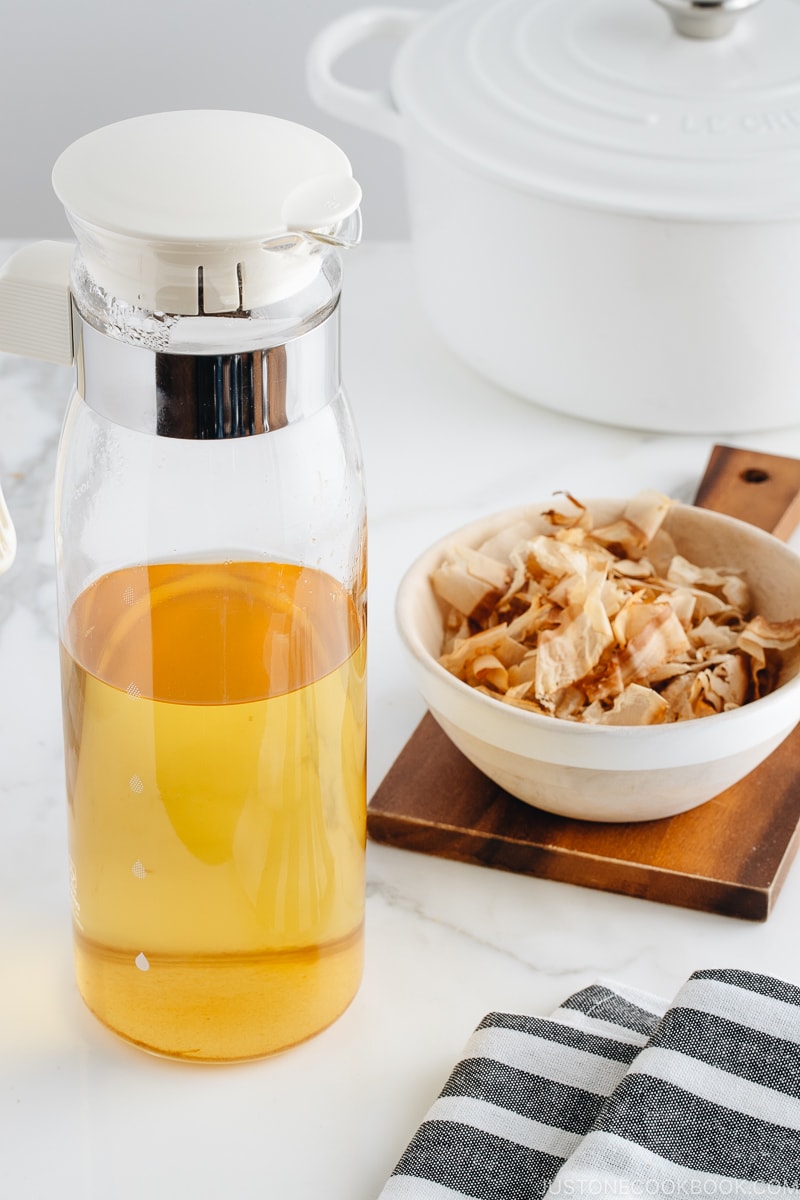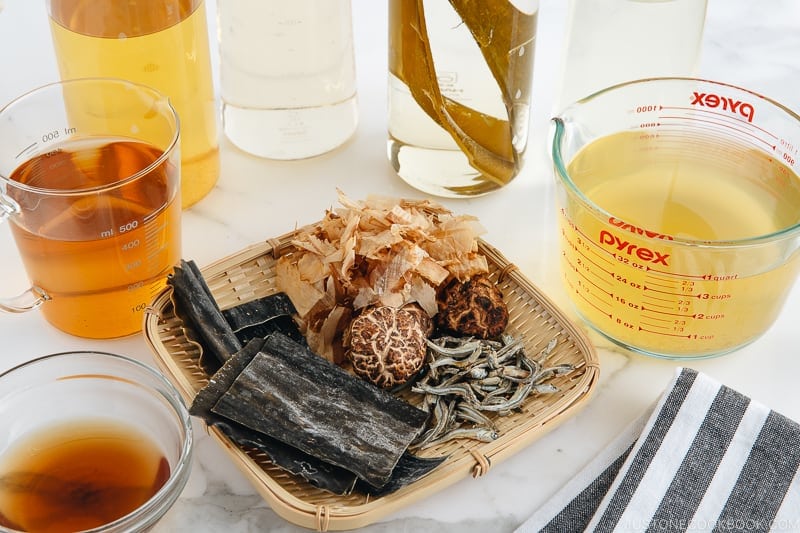
Learn how to make Katsuo Dashi, a Japanese soup stock made from dried bonito flakes. With its savory and distinct umami aroma, this soup stock is a game changer in your Japanese cooking, and can turn a lackluster ramen bowl into something extraordinary!

There are numerous methods and ingredients in making dashi, Japanese soup stock that lays the foundation for many Japanese dishes. I’ve shared all the different recipes in making dashi (including vegetarian versions) on Just One Cookbook, but today I want to share how to make Katsuo Dashi (かつおだし).
What is Katsuo Dashi?
Katsuo Dashi (かつおだし) is made from katsuobushi (かつおぶし, 鰹節), dried and fermented bonito/skipjack tuna that is shaved into thin flakes. In Japanese cooking, the distinct umami taste from katsuobushi plays an important role to help heighten flavors and senses.
Unlike other dashi ingredients such as kombu, iriko (niboshi), and shiitake mushrooms, katsuobushi does not need to be soaked before making delicious dashi. In other words, you can start making Katsuo Dashi now, and it only takes less than 15 minutes to make a rich and savory soup stock.
How to Make Katsuo Dashi
Just like all types of dashi, Katsuo Dashi is unbelievably easy to make.
You just need to bring the water to a near boiling point and add katsuobushi shavings to the water. Let them sink in the pot and strain.
Just like that, you get a beautiful golden color of Katsuo Dashi.
Watch How to Make Katsuo Dashi
Learn how to make Katsuo Dashi, a Japanese soup stock made from dried bonito flakes. With its savory and distinct umami aroma, this soup stock is a game changer in your Japanese cooking!
Recipes Using Katsuo Dashi
You can use katsuo dashi in miso soup or your ramen stock if you like, but below you can find recipes specifically use Katsuo Dashi:
The Ultimate Dashi Guide on Just One Cookbook
Dashi is the master flavor enhancer in Japanese cooking, so you don’t need to season the food with too much salt, fat, and sugar. Its function is as indispensable as cooking oil, so anyone who is keen to cook authentic Japanese dishes at home will have to get started with dashi.
There are five different types of dashi you can use in Japanese cooking, including vegetarian and vegan dashi (*).
- Kombu Dashi → made from kombu (dried kelp)*
- Katsuo Dashi → made from katsuobushi (dried bonito flakes)
- Iriko Dashi → made from iriko or niboshi (dried anchovies/sardines)
- Shiitake Dashi → made from dried shiitake mushrooms*
- Awase Dashi → made from a combination of all above or two (e.g., kombu + katsuobushi)
If you are new to different types of dashi, check out my Ultimate Dashi Guide post.
![]()
Sign up for the free Just One Cookbook newsletter delivered to your inbox! And stay in touch with me on Facebook, Pinterest, YouTube, and Instagram for all the latest updates.
Katsuo Dashi (Bonito Stock)

Learn how to make Katsuo Dashi, Japanese soup stock made from dried bonito flakes. This stock enhances your Japanese meal with authentic flavor!
- ⅔ oz katsuobushi (dried bonito flakes) ((20 g, 2 cups))
- 4 cups water ((roughly 1000 ml))
- Gather all the ingredients.

- In a medium pot, bring water to a boil.

-
Just before water starts boiling, add the katsuobushi and bring it to a boil again, skimming occasionally.

- Once the dashi is boiling, reduce the heat, simmer for just 30 seconds, and turn off the heat.

- Let the katsuobushi sink to the bottom, about 10 minutes.

-
Strain the dashi through a fine-mesh sieve over a bowl or measuring cup (Reserve the katsuobushi and see below for what to do with it). Katsuo Dashi is ready to use.

To Store
- If you are not using the dashi right away, store the dashi in a bottle or mason jar and keep in the refrigerator for 3-5 days or in the freezer for 2 weeks.

What to Do with Used Katsuobushi
-
Save the drained katsuobushi to make Homemade Furikake rice seasoning or Kombu Tsukudani. If you don’t use it right away, you can freeze them for 2-3 weeks.

Recipe by Namiko Chen of Just One Cookbook. All images and content on this site are copyright protected. Please do not use my images without my permission. If you’d like to share this recipe on your site, please re-write the recipe in your own words and link to this post as the original source. Thank you.
from Merah Hati Cintaku http://bit.ly/2XYhfUK
via MerahHatiCintaku.blogspot.com
